UK: Broad-bordered Bee Hawkmoth, F: Sphinx Gazé; Sphinx du Chèvrefeuille, D: Hummelschwärmer, RUS: Brazhnik Shmelevidnyi zhimolostnyi, S: Humlelik Dagsvärmare, NL: Glasvleugelige Pijlstaart, CZ: Dlouhozobka chrastavcová; Dlouhozobka zimolezová, H: dongószender, E: cristalina borde estrecho; esfinge abejorro de orla ancha, PL: Fruczak bujankowiec, FIN: Kuusamakiitäjä, I: Sfinge fuciforme, HR: širokorubi bumbarasti ljiljak, DK: Bredrandet humlebisværmer, N: Bredkantet humlesvermer, EST: Kimalas-lottsuru.
Sphinx fuciformis Linnaeus, 1758, Syst. Nat. (Edn 10) 1: 493.Type locality: Europe.
(Taxonomic notes. (i) Although very close, recent DNA barcoding studies have demonstrated that Hemaris fuciformis jordani (Clark, 1927) from Morocco and Algeria is sufficiently distinct from Hemaris fuciformis fuciformis to warrent subspecific status. However, very similar-looking populations can be found in the montane coniferous forests of southern Spain, central Greece and Turkey. This requires further study.
(ii) The descriptions and illustrations provided by Daniel (1932; 1939) of the Turkish Hemaris fuciformis subsp. syra (Daniel, 1939), initially indicated that it could be a form of Hemaris dentata (Staudinger, 1887). However, Daniel (1932) was of the opinion that it was closer to Hemaris fuciformis, although the colour of the thorax and abdomen reminded him more of Hemaris croatica (Esper, 1800). Danner, Eitschberger & Surholt (1998) treated Hemaris syra as a good species, although they were uncertain of its exact status. Kitching & Cadiou (2000) compared Hemaris syra, Hemaris fuciformis and Hemaris dentata (Staudinger, 1887) from Turkey and concluded that Hemaris syra probably represented the opposite sex of the sexually dimorphic Hemaris dentata. With the capture of further specimens of both Hemaris syra and Hemaris dentata it became clear that Hemaris syra was not conspecific with Hemaris dentata, but in morphology much closer to Hemaris fuciformis. However, the results of recent DNA barcoding studies indicate that although this taxon is close to Hemaris fuciformis and Hemaris dentata, it is sufficiently distinct from either to warrent specific status.)
[Further details on this species, as well as photos of all stages, can be found on Lepiforum.]
![A plate from Lucas, H. [1864]. A plate from Lucas, H. [1864].](lucas1864b.jpg)
Holarctic; western Palaearctic region. Pleistocene refuge: Polycentric -- Atlantomediterranean and Pontomediterranean refugia.
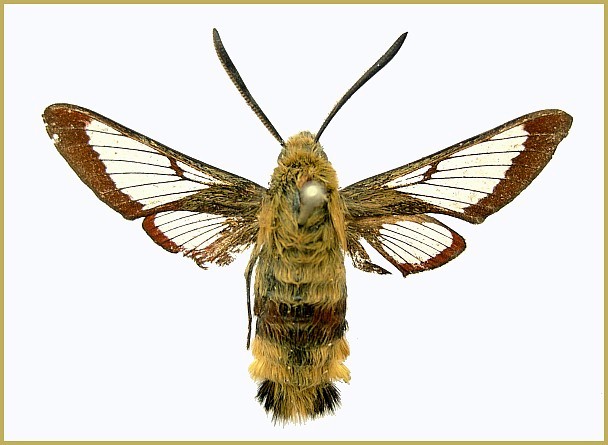
Wingspan: 38--48mm. Distinguished from Hemaris tityus (Linnaeus, 1758) by a much broader marginal band to the wings; forewing discal cell divided longitudinally by a fold in most examples. More variable than Hemaris tityus: in f. musculus Wallengren, all olive green coloration is replaced by reddish grey; in f. heynei Bartel, black as opposed to normal brown is the dominant colour of the central abdominal belt.
In the male genitalia, uncus scarcely more than twice as long as proximally broad, the two halves separated only at the extreme apex. Juxta rough with setiferous granules, a little more produced ventrally than dorsally. Valves asymmetrical; left valve spatulate; right valve with concave dorsal margin, and ventral margin deeply sinuate just beyond middle, apical lobe spatulate. Left harpe represented by a basal thickening that bears a few short setae; right harpe represented by a conical process, individually variable and clothed with setae. Phallus apical process flattened, obtuse.
Individuals of Hemaris fuciformis fuciformis resembling Hemaris syra can occasionally be found in Greece and Italy, particularly in the second brood.
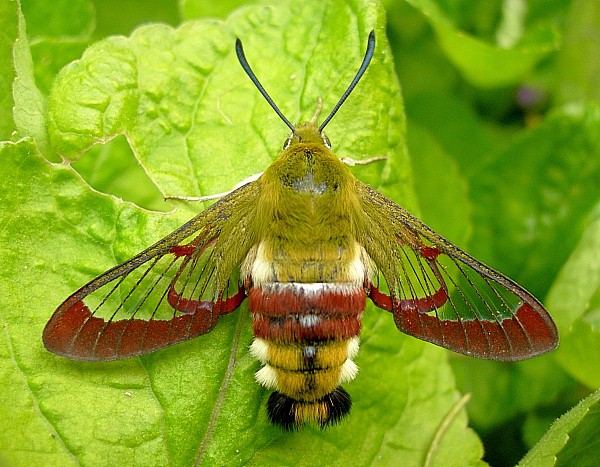
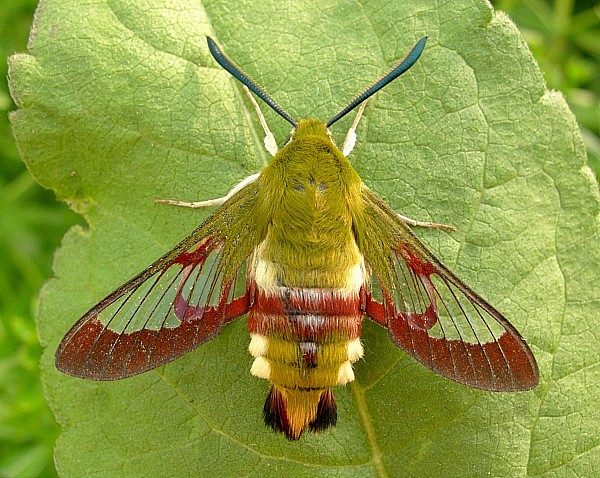
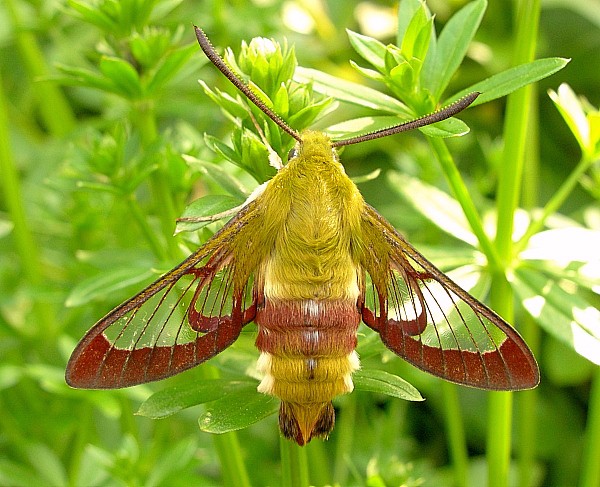
Diurnal. In northern Europe, frequents the Lonicera-entwined edges of sunny glades in open woodland. Farther south, displays a marked preference for sand- and chalk hills lightly overgrown with conifers and shrubby honeysuckles, such as Lonicera xylosteum and Lonicera tatarica, where it is often extremely abundant. It was formerly also abundant in many marginal areas (Tatchell, [1926]), but modern practices of woodland management have severely reduced its numbers. Generally avoids open meadows, preferring to fly along woodland margins or rides; however, in Turkey and the Crimea it often breeds in meadows and gardens.
In behaviour, this species closely resembles Hemaris tityus: active by day, usually from about 10.00 hours, it avidly searches along rides and forest edges for the flowers of Rhododendron, Silene, Ajuga, Lychnis and Pulmonaria. Some may even venture into gardens to be seen at Syringa and Phlox. It is in such situations that courtship and pairing take place; the female then takes flight in search of Lonicera growing in partial shade on which to lay her eggs. If disturbed at any time, this species flies off at great speed.
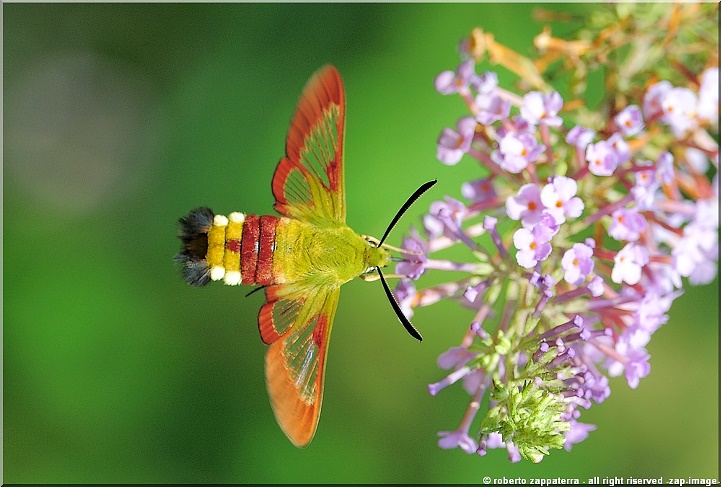
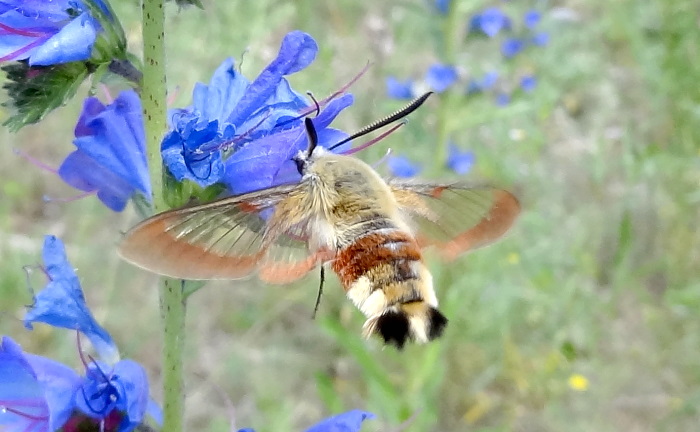
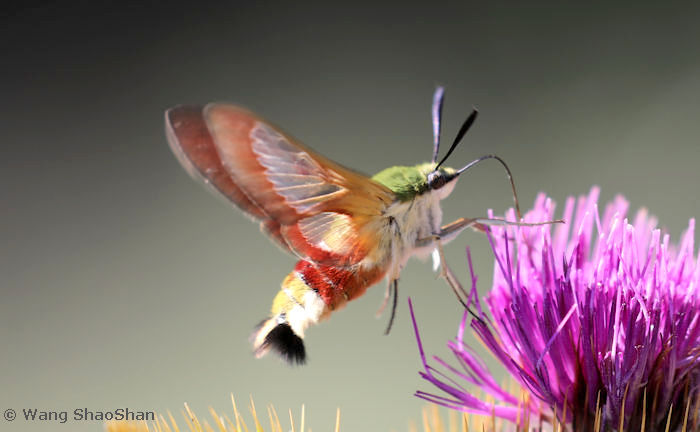
Bivoltine throughout its southern range. In northern Europe, late May to mid-June, with a partial second brood in August; a single generation in June is normal for the mid Urals (Eversmann, 1844), Tian Shan (Grum-Grshimailo, 1890) and higher altitudes in Bulgaria (Ganev, 1984). In the southern Urals, from mid May until early July (Nupponen & Fibiger, 2002).
Two individuals were captured on 21.vi & 10.vii.1964 at Oktyabr'skoe in western Siberia (Ob' River, 62°30'N) (Vladimir Dubatolov, pers. comm 2012).
In October 1994, several adults were observed at Nicotiana blossom in Suffolk, England (Hagget, 1995). These may have been part of an attempt at a partial third brood.
OVUM: Small (1.1 x 1.0mm), pale glossy green, nearly spherical. Laid singly or in pairs on the underside of the leaves of its hostplant; plants growing in either deep shade or in the open are avoided.
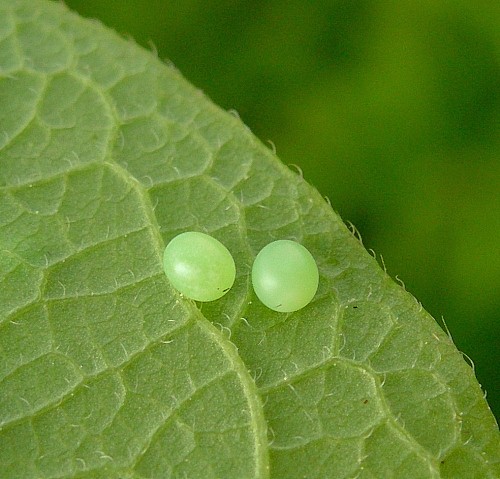
LARVA: Full-fed 40--45mm.
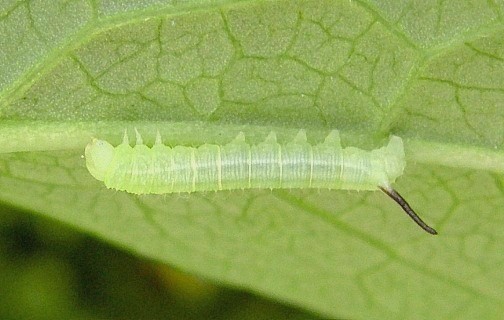
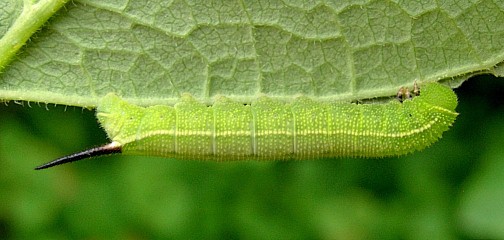
On hatching, the 3mm-long, whitish yellow larva rests along the midrib on the underside of a leaf, occasionally nibbling oval holes in the latter. Most feed at night, resting during daylight hours in a typical sphinx-like attitude. Fully grown, some have reddish spots and blotches bordering the dorso-lateral line and spiracles which, combined with a very rough, tubercled skin, camouflage the larva well. At this stage it generally sits under a twig. If disturbed or alarmed, it will drop to the ground, although not as readily as Hemaris tityus.
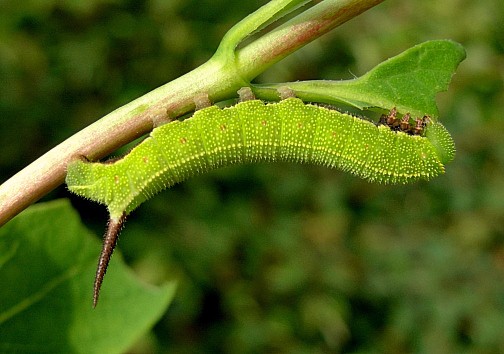
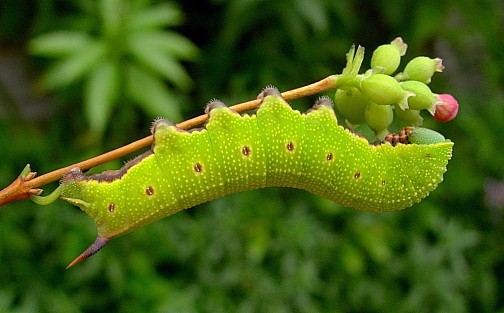
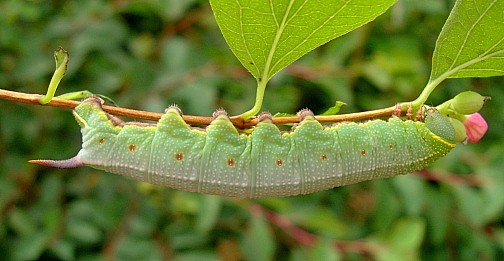
In some years brown (illustrated) or golden larval forms can be found, although this is rare. In 1999, 5-10% of larvae near Toulon, France, were so coloured (J.-M. Bompar, pers. comm.).
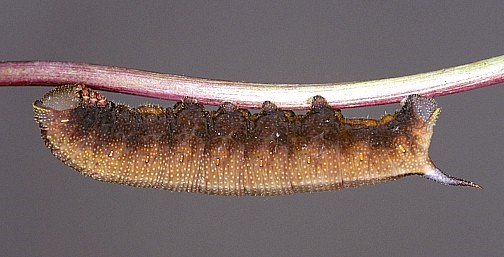
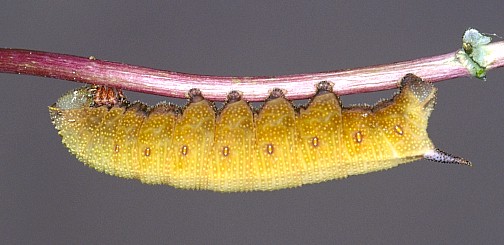
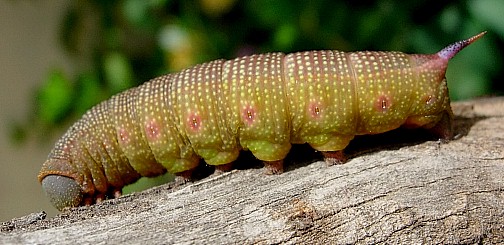
Occurs from mid-June until early August over central and northern Europe, but from May until September farther south.
Major Hostplants. Lonicera spp. in northern Europe, particularly Lonicera periclymenum; in central and southern parts of its range, the shrubby Lonicera nigra, Lonicera xylosteum and Lonicera tatarica are favoured.
Minor Hostplants. Symphoricarpos, Galium, Deutzia and Knautia; in Turkey mainly Cephalaria procera (de Freina, 1979). In Kyrgyzstan on Lonicera microphylla Willd. ex Schult. and Lonicera tatarica (Toropov, Milko, Zhdanko & Evdoshenko, 2023).
PUPA: 23--25mm. Similar to that of Hemaris tityus: blackish brown with glossy highlights and brown, intersegmental cuticle. Formed on the ground in a loosely spun silken cocoon interwoven with debris. The overwintering stage.
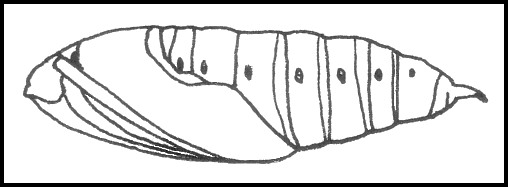
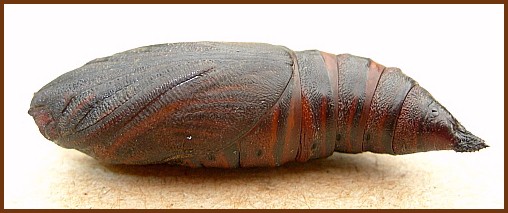
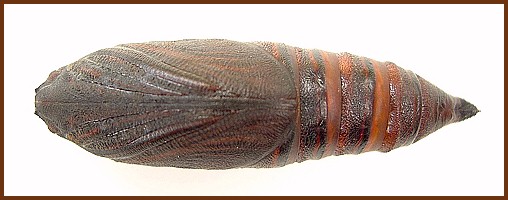
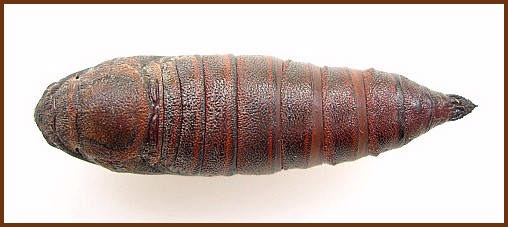
Ichneumonidae: Amblyjoppa fuscipennis (Wesmael, 1845); Braconidae: Cotesia coryphe (Nixon, 1974), Cotesia glomerata (Linnaeus, 1758); Tachinidae: Carcelia rasella Baranov, 1931, Masicera sphingivora (Robineau-Desvoidy, 1830), Tachina praeceps Meigen, 1824.
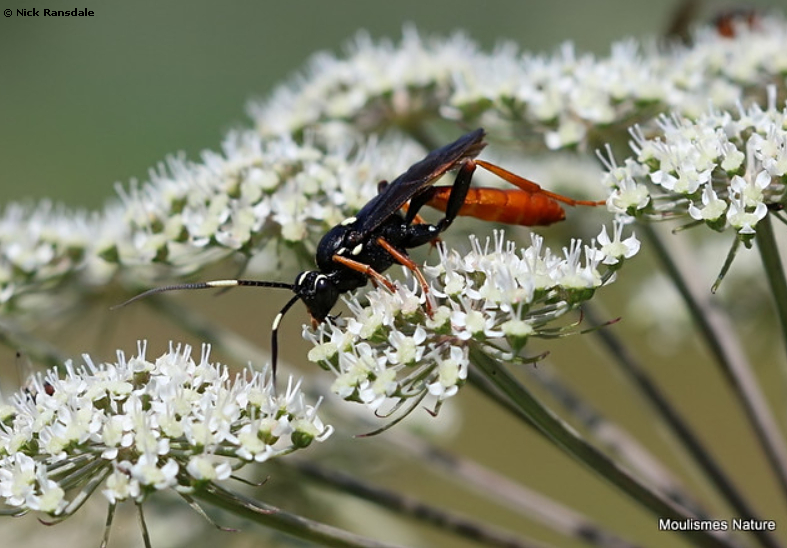
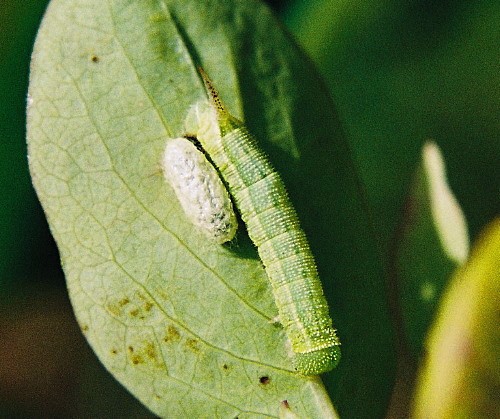
Similar to Hemaris tityus, but confined to mountain refugia in southern and central parts of the Iberian Peninsula (Gomez Bustillo & Fernandez-Rubio, 1976; Pérez De-Gregorio et al., 2001; Ortiz, Garre, Guerrero, Rubio & Calle, 2010; Lara Ruiz, 2011), including at 1250m in the Sierra de la Yedra mountains, Granada Province, southern Spain (Rambur, 1942; Perez Lopez, 1989), and at Abacete and Guadalajara (Aistleitner & Aistleitner, 1998). It is present, but rare, farther north in Navarra Province (Cifuentes, 1997) and Galicia (Pino Pérez et al., 2009; Fernández Vidal, 2016), as well as Asturias (Torralba-Burrial & Outomuro, 2011). Otherwise, from Spain and Portugal (Pires & Corley, 2007) and Puglia, southern Italy (Parenzan, Sannino, Scalercio & Sciarretta, 2007), through Europe to the Ukraine (Plyushch & Sheshurak, 1997; Khalaim, 2022), Crimea (Efetov & Budashkin, 1990), Urals, eastern and southeastern Kazakhstan (Danner, Eitschberger & Surholt, 1998; Dubatolov, [1999]; Toropov, Milko, Zhdanko & Evdoshenko, 2023), Kyrgyzstan (Rasmus Kray, iNaturalist 2022; Toropov, Milko, Zhdanko & Evdoshenko, 2023), western Siberia (Eversmann, 1844; Izerskiy, 1999; Knyazev, 2020) and the Altai Mountains (Zolotarenko, Petrova & Shiryaev, 1978; Izerskiy, 1999; Alexey Ebel, iNaturalist 2015). Also, the Republic of North Macedonia (Krpač et al., 2019), central Greece, northern Turkey (Lederer, 1855; Daniel, 1932; Daniel, 1939; de Freina, 1979; Okyar, 2012), northern Iran (Lehmann & Zahiri, 2011; Didmanidze, Petrov & Zolotuhin, 2013), the Republic of Georgia (Didmanidze, Petrov & Zolotuhin, 2013; Streltzov et al., 2022), Armenia (Wąsala & Zamorski, 2015) and Azerbaijan (Didmanidze, Petrov & Zolotuhin, 2013; Snegovaya & Petrov, 2021), northern Afghanistan (Ebert, 1969), the Tian Shan of Tajikistan (Alpheraky, 1882; Grum-Grshimailo, 1890; Derzhavets, 1984) and southeastern Kazakhstan (Sergey Rybalkin, pers. comm. 2014). Also, as an isolated population, Himachal Pradesh, the Punjab and Uttarakhand in northern India (Moore, 1888; Kaleka, Singh & Kaur, 2015). Absent from Ireland (Lavery, 1991), Scotland (Gilchrist, 1979), northern Scandinavia and Arctic Russia; however, recorded as far north as Arkhangelsk Oblast (Kozlov, Kullberg & Zverev, 2014) and Izhma (Tatarinov, Sedykh & Dolgin, 2003) in european Russia, Oktyabr'skoe in western Siberia (Ob' River, 62°30'N) (Vladimir Dubatolov, pers. comm. 2012), as well as from Sardinia and Sicily.
[It is possible that most, if not all, populations of Hemaris fuciformis fuciformis reported from central and southern Turkey are, in fact, Hemaris syra, and that Hemaris fuciformis fuciformis is rare in Turkey and confined to the northern Pontic Mountains fringing the Black Sea -- there is one confirmed record from Ayancik near Sinop. Individuals have also been confirmed from the Alborz Mountains of northern Iran (Lehmann & Zahiri, 2011) and from Azerbaijan (Snegovaya & Petrov, 2021).]
Extra-limital range. From the Altai Mountains (Alexey Ebel, iNaturalist 2015) eastwards across southern Siberia (Eversmann, 1844; Zolotarenko, Petrova & Shiryaev, 1978; Izerskiy, 1999), southern Yakutia/Sakha (Kaimuk et al., 2005) and Transbaikalia to the Russian Far East (Izerskiy, 1999), and Sakhalin Island (Chistyakov & Belyaev, 1984; Dubatolov, 1991).
Records from South Korea (Kim et al., 1982; Kim, Tshistjakov & Kwon, 1999) are misidentifications of Hemaris affinis (Bremer, 1861), a distinct species occurring in Japan, the Russian Far East and northeastern China (Chu & Wang, 1980b).
The Atlas Mountains of Morocco and Algeria as Hemaris fuciformis jordani (Clark, 1927). 'Subsp.' ganssuensis Grum-Grshimailo, 1891 from Xizang Province/Tibet is the eastern palaearctic Hemaris affinis.
 Return to species list
Return to species list